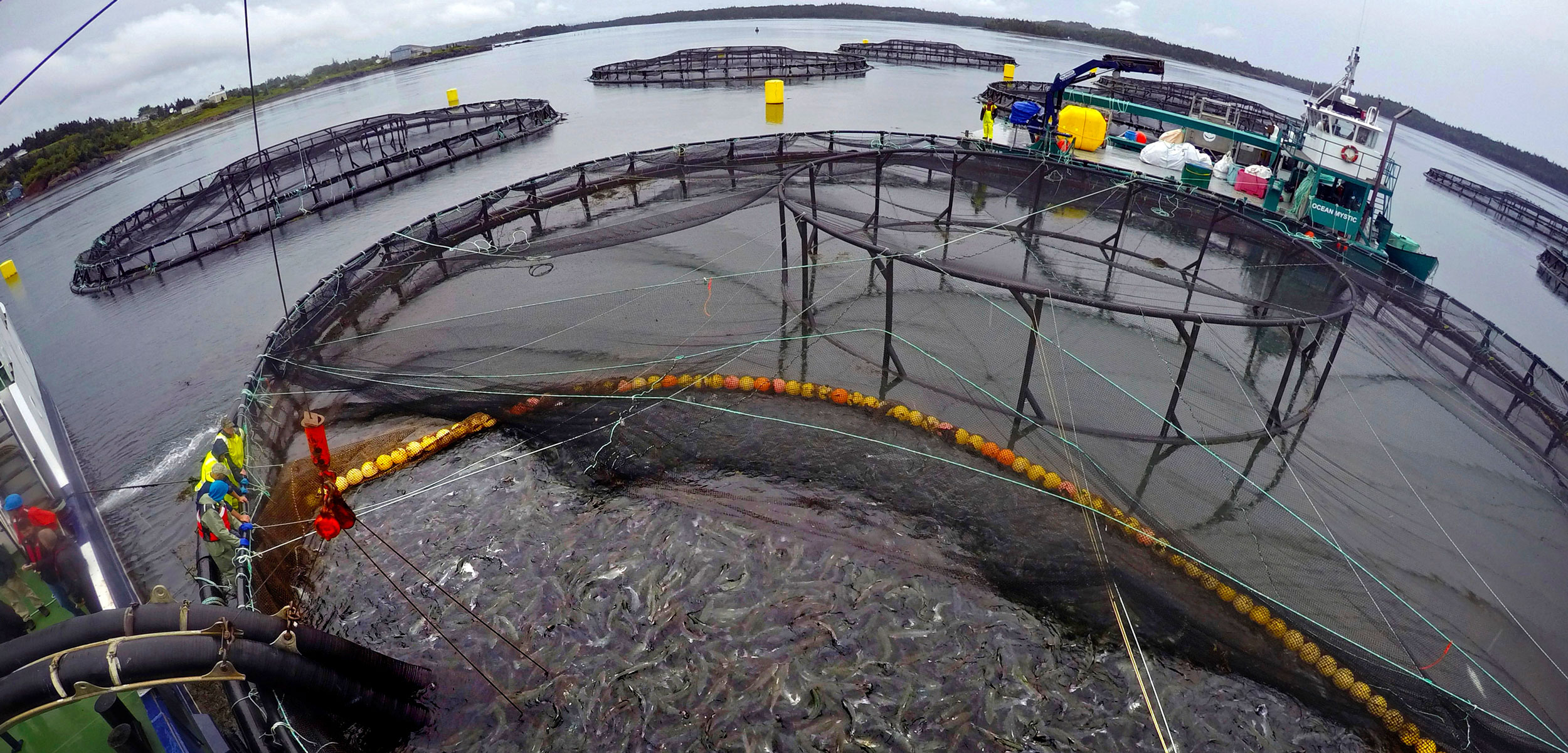New Genetic Research Shows the Legacy of Fish Farm Escapees
A study suggests that escaped farmed salmon are breeding in Newfoundland’s rivers—with dire consequences for wild fish.
Article body copy
Newfoundland’s great fish jailbreak took place on September 18, 2013, when a damaged sea pen, roiled by currents and tides, discharged 20,000 farmed Atlantic salmon into the frigid freedom of Hermitage Bay. Cooke Aquaculture, which owned the failed pen, swiftly set about controlling the damage in the media, if not the ocean. Seals and other predators would scarf up the rogue salmon, the company assured the CBC. The fish, it added, “pose[d] no threat to the environment.”
A new genetic analysis, however, refutes that dubious claim. Researchers with Fisheries and Oceans Canada (DFO) have shown that the fish fled Hermitage Bay, fanning out and infiltrating many of southern Newfoundland’s rivers. There, the escapees interbred with their wild cousins—potentially weakening the gene pools of imperiled populations.
“It’s a huge problem,” says Steve Sutton, director of community outreach and engagement at the Atlantic Salmon Federation. “And it’s one that’s not likely to go away as long as we’ve got salmon farms next to salmon rivers.”
A year after the fish broke free, DFO biologists waded through 18 Newfoundland rivers, pulsing electric currents through the water and scooping up 1,704 stunned baby salmon. Then the team, led by biologist Brendan Wringe, analyzed the juveniles’ genes to determine whether their parents had been born in the wild or fled from the farm. Such analysis is possible, in part, because all of the farmed salmon raised in Eastern Canada originate from a single source, New Brunswick’s Saint John River, and are part of a population that’s genetically distinct from Newfoundland’s wild fish.
Wringe suspected the analysis would uncover signs of interbreeding, but even he was surprised at the magnitude of the mingling. Seventeen of the 18 rivers tested contained the hybrid offspring, while 13 also had “feral” fish—the products of two farmed parents. Altogether, more than a quarter of the babies tested had aquacultural ancestry.
What’s more, DFO scientists discovered that the problem of escaping fish is much larger than isolated, large-scale releases such as the massive 2013 breakout.
While many of the crossbred babies were first-generation hybrids—the offspring of a wild fish and a recent escapee—others were so-called F2s, the offspring of hybrid parents. Those juveniles, in other words, had grandparents that had escaped from a farm. For the timeline to make sense, these fish must have escaped well before the major 2013 break. Because aquaculture companies are not required to report escapes of fewer than 100 fish, there’s no telling when those accidental releases may have occurred.
The takeaway: big getaways grab headlines, but Canada’s rivers are also besieged by a stealthy stream of farm fugitives, their desertions unreported and perhaps undetected.
“There is some evidence that trickle escapes can be more damaging in the long term to the genetics of a population than a large escape event,” Wringe says. “It’s analogous to the introduction of invasive species: the more chances you have, the more likely you are to be successful.”
Newfoundland’s 2013 fiasco is far from the only recent salmon escape. In August 2017, a Cooke Aquaculture net pen in Washington State was torn apart by strong tides, discharging 300,000 Atlantic salmon into Puget Sound. Although biologists and fishermen expressed plenty of concerns—including the transmission of disease and the potential for escapees to compete with wild fish for prey or spawning grounds—they didn’t have to worry about hybridization. Interbreeding between Atlantic salmon and the five species of Pacific salmon is generally considered impossible.
In Eastern Canada, by contrast, where wild and farmed salmon are the same species, interbreeding is a serious threat. The genes of wild salmon have been fine-tuned by generations of natural selection, leaving them intimately adapted to their natal rivers. Farmed salmon, insulated by captivity from evolutionary pressure, are presumably less equipped for survival. Should they contaminate the gene pool, the whole population may become weaker. In 2003, researchers in Ireland found that repeated farm escapes could eventually lead some salmon runs down an “extinction vortex.”
Sutton cautions that farm escapes could likewise be “eroding the resilience” of Newfoundland’s salmon populations. In his study, Wringe found that hybrids were more abundant in smaller rivers, perhaps because they faced less competition from wild fish. As those wild runs plummet under the weight of various pressures—including poor ocean conditions that have reduced salmon survival at sea—it may become easier still for farmed escapees to establish themselves.
“The issues facing salmon are multifaceted,” Wringe says. “But in the grand scheme of things, hybridization will likely have a detrimental effect on the wild population.”
Although the proportion of hybrids in Newfoundland’s rivers has declined since 2014, interbreeding rates are likely to spike again. In late July, a rope came undone on another Cooke net pen, releasing up to 3,000 farmed salmon into the province’s waters. Some of those runaways are almost surely cruising upriver this fall, preparing to swap milt and eggs with their wild brethren. The only way to stem the hybridization tide, says Sutton, is to pass tougher regulations designed to prevent escapes in the first place. “Once it happens,” he adds, “there’s not much you can do.”

